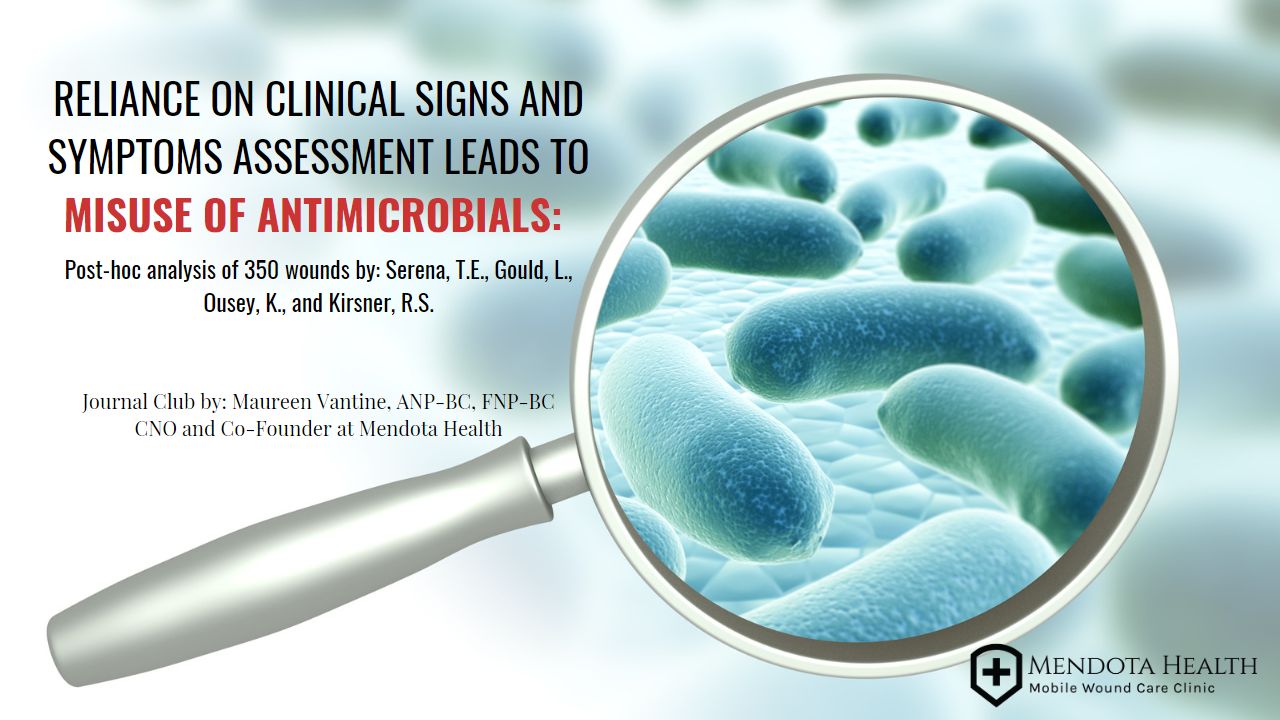
03 Jan Reliance on Clinical Signs and Symptoms Assessment Leads to Misuse of Antimicrobials
Bacterial presence and infection are frequent barriers to chronic wound healing. Clinicians regularly rely on clinical signs and symptoms (CSS) to determine appropriateness of topical or systemic antibiotic treatment as a component of a chronic wound healing plan of care. Additionally, CSS are relied upon to determine when to employ objective measures of bacterial burden. In this post-hoc analysis, Serena, et al. evaluates the antimicrobial prescribing practices based on clinical signs and symptoms across 14 wound centers. This is the first study to examine the relationship between anti-microbial prescribing, clinical signs and symptoms of infection, and total bacterial load in a wound.
STUDY DESIGN
Post-hoc analysis was performed on the data from the Fluorescence Assessment and Guidance (FLAAG) clinical trial conducted in 2018. The study included adult patients with wounds of unknown infection status and various etiologies with broad inclusion and exclusion criteria. Clinical investigators assessed the wounds for Clinical Signs and Symptoms (CSS) of infection using the International Wound Infection Institute (IWII) Wound Infection Checklist Criteria. Based on the CSS assessment, the investigators recorded a 4-week treatment plan for the wound which could include the use of antimicrobial dressings, topical antimicrobial, and/or topical or systemic antibiotics. A biopsy of the wound was obtained and processed by a third-party lab for quantitative analysis of the bacterial load. The lab was blinded to the CSS findings.
This study found that the scope of bacterial burden in wounds was largely underestimated when relying on clinical signs and symptoms alone, or as a tool to determine when to objectively measure bacterial loads in wounds.
CONCLUSIONS
Bacterial Burden
This study found that the scope of bacterial burden in wounds was largely underestimated when relying on clinical signs and symptoms alone, or as a tool to determine when to objectively measure bacterial loads in wounds. 86% of study wounds were negative for CSS, while 14% of wounds were positive for CSS using IWII criteria. Conversely, bacterial loads of > 10^4 colony-forming units/gram (CFU/g) were observed in 82% of study wounds, while 52.2% of study wounds had bacterial loads > 10^6 CFU/g. Previous studies have demonstrated that accumulation of bacteria at concentrations > 10^4CFU/g has been associated with decreased wound healing. Thus, the CSS criteria had poor sensitivity (<15%) for identifying wounds with high bacterial burden. Based on these findings, it can be assumed many wounds with a bacterial burden that can impair wound healing are being left untreated.
Antimicrobial Prescription
Antimicrobials were prescribed to a similar proportion of CSS positive (75%) and CSS negative (72.8%) wounds. This indicates wound care prescribing practices of antimicrobials were haphazard in the study. Applying this finding to prescribing practices in wound care in general would suggest a delay in necessary antimicrobial treatment for some patients, and an over prescription of antimicrobials in other patients. Similarly, when considering antimicrobial prescription correlation with bacterial burden, all CSS positive wounds with a bacterial load of <10^4 CFU/g were prescribed antimicrobials, but only 66.7% of CSS positive wounds with > 10^8 CFU/g were prescribed antimicrobials. This again illustrates inconsistent antimicrobial prescribing practices related to both presence of CSS and total bacterial load. Interestingly, the antibiotic prescribing rate was highest (75%) in CSS positive wounds with bacterial loads < 10^4 CFU/g.
LIMITATIONS
Inclusion and exclusion criteria for this study was broad, which ensured a fair representation of wounds commonly seen in wound care clinics. This variability could lead to additional factors that may have influenced clinician’s decisions related to antimicrobial prescribing. Additionally, data analyzed in this study was from a single visit that captured bacterial load and prescribing practices at one point in time, which may not be indicative of practices over the course of the patient’s care plan.
CLINICAL APPLICATION
This study demonstrated very poor correlation between antimicrobial prescribing practices, clinical signs and symptoms of infection, and total bacterial load. Undoubtedly, current wound care practices involve a high rate of over-prescription of antimicrobials, contributing to the problem of antibiotic resistance and inhibiting the success of antibiotic stewardship programs. Conversely, the haphazard prescribing practices demonstrated in this study also include under-prescription or delayed prescription of antimicrobials in wounds with a high bacterial load that require antimicrobial treatment for healing.
Appropriate use of antimicrobials in chronic wounds would lead to decreased time to healing, decreased overall use of antimicrobials, and a return to improved quality of life and function for patients. Additionally, health care providers have an important role to play in antimicrobial stewardship. This study suggests that wound care providers should be considering objective methods for determining bacterial burden in wounds rather than relying on clinical signs and symptoms to make these determinations. There are several point-of-care diagnostics available that enhance detection of bacterial burden in wounds such as wound culture, PCR, dressings that change color with the presence of pathogenic organisms, and fluorescent imaging devices. More research is needed on the clinical use of such diagnostics and their role in the overall care plan of a chronic wound patient.
REFERENCES
Serena, T.E., Gould, L., Ousey, K., and Kirsner, R.S. Reliance on clinical signs and symptoms assessment leads to misuse of antimicrobials: post-hoc analysis of 350 chronic wounds. Advances in Wound Care 2022; 11: 639-649.

